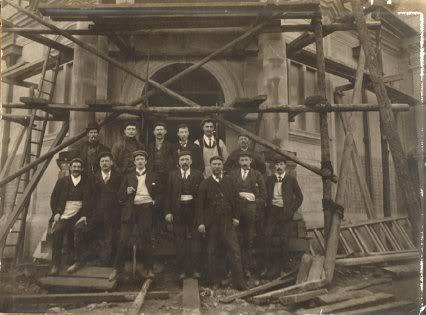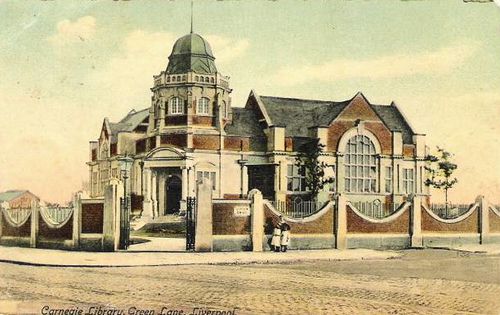The Andrew Carnegie Library: A Brief History

The first public library in Liverpool, a reference library, opened in the Union Newsroom building on the corner of Duke Street and Slater Street in 1852. The first purpose built library was constructed in 1860 on William Brown Street however library services were slow to develop in areas outside the town centre. Peter Cowell (1838-1909), Liverpool’s third Chief Librarian (appointed to the post in 1875), was responsible for the programme of construction of branch libraries in Liverpool.
Andrew Carnegie (wealthy philanthropist), on his first visit to Liverpool in 1902, attended the opening ceremony of Toxteth Library. As a result of this visit he offered to finance the first of six branch libraries, the Andrew Carnegie Library. Between 1902 and 1913 Andrew Carnegie gave grants to construct six branch libraries in Liverpool: West Derby (1905) (re-named The Andrew Carnegie Library after the grant offer), Kirkdale (1905), Garston (1909), Walton and Fazakerley (1911), Sefton Park (1911) and Old Swan (1913).
Plans were already in place to construct a branch library in West Derby prior to Andrew Carnegie’s donation. In June 1900 the Library, Museum and Arts Committee purchased the land and Architect Thomas Shelmerdine was commissioned to draw plans*. A letter from Andrew Carnegie to Sir William Forwood, dated 16th December 1902, discusses the intention of building and funding the library and reads:
‘My Dear Sir William,
Delighted to hear of the progress of the Toxteth Library.
You mentioned that you wishes to build another such branch somewhere costing about £13’000. If it would not be considered intrusive I should like to testify my appreciation of the public spirit of Liverpool, and especially of its partnership in the free library movement. It has a great record, having established a free library before the advent of the Libraries Act. Besides this, I was deeply impressed by the number of able citizens who give so much of their time, not to aims that end with miserable self, but for good of the community.
I do not make the practice of volunteering. I depend upon you and such of your other friends that I had the pleasure of meeting, to be sure the offer would be universally received with approval.
Please be sure to consult the late Lord Mayor, my fellow countryman, in your counsels, and believe me
Always very truly yours,
Andrew Carnegie'
Fifteen tenders were submitted and considered during a Library, Museum and Arts Committee meeting on 27th August 1903. The second lowest tender of £15’570 by Brown and Blackhouse was accepted. Construction began in 1903 and was completed by June 1905 when Thomas Shelmerdine advised the Library, Museum and Arts Committee to instruct the Librarian to purchase books. Andrew Carnegie was unable to attend the opening and so instead Sir William Forwood officially opened the library on 27th June 1905.
The building, the wall and gatepiers became Grade II listed on 19th June 1985 under the Planning (Listed Buildings and Conservation Areas) Act 1990 as amended for its special architectural or historic interest. List Entry Number 1298769, the wall and gatepiers to West Derby Library states:
‘Wall to Green Lane and Lister Drive, with gate piers at angle. 1904. T.Shelmerdene. Brick with swept coping between wall piers with battered panels and hemi-spherical caps. Plain iron railings between piers. Gate piers as wall piers but larger.’
List Entry Number 1356361, the building, states:
Library. 1904. T Shelmerdine. Brick with stone dressings, slate roof. One storey, 4 bays canted corner bay and 4-bay right return; 1st 3 bays project. Sill course, painted pilasters, pulvinated frieze, cornice and parapet. Windows have mullions and transoms. 3 2nd bay round-headed window under gable. Corner has octagonal turret, with buttresses and arcaded parapet. Segmental-headed windows have eared architraves with triple keys. Domical vault in 2 stages. Round-headed entrance has ionic porch with pulvinated frieze and segmental pediment. Right return similar. Left return and rear facades have 2 canted bays.
Sadly, following health and safety concerns, the library closed in 2006 and has remained vacant since. This period of un-occupation has resulted in the library being subject to theft, vandalism and neglect. Items stolen from the library include lead flashings, the glazing to roof lights and feature ridge tiles. There has been substantial rainwater ingress which has severely damaged the timber structure and internal decorative plasterwork and joinery and dry rot is common throughout the building.
In August 2014, following a successful Stage 1 pass from the Heritage Lottery Fund, emergency holding works started in the former library to 'stop the rot'. The next stage in this iconic buildings history has begun...
*Branch libraries in Liverpool which were not funded by Andrew Carnegie but were designed by Thomas Shelmerdine include Kensington (1890 & extended in 1897), Everton (1896), Toxteth (1902), Wavertree (1903)
With thanks to Alison Doran, John Tiernan and Douglas Wall for their excellent research contributions.
Andrew Carnegie (wealthy philanthropist), on his first visit to Liverpool in 1902, attended the opening ceremony of Toxteth Library. As a result of this visit he offered to finance the first of six branch libraries, the Andrew Carnegie Library. Between 1902 and 1913 Andrew Carnegie gave grants to construct six branch libraries in Liverpool: West Derby (1905) (re-named The Andrew Carnegie Library after the grant offer), Kirkdale (1905), Garston (1909), Walton and Fazakerley (1911), Sefton Park (1911) and Old Swan (1913).
Plans were already in place to construct a branch library in West Derby prior to Andrew Carnegie’s donation. In June 1900 the Library, Museum and Arts Committee purchased the land and Architect Thomas Shelmerdine was commissioned to draw plans*. A letter from Andrew Carnegie to Sir William Forwood, dated 16th December 1902, discusses the intention of building and funding the library and reads:
‘My Dear Sir William,
Delighted to hear of the progress of the Toxteth Library.
You mentioned that you wishes to build another such branch somewhere costing about £13’000. If it would not be considered intrusive I should like to testify my appreciation of the public spirit of Liverpool, and especially of its partnership in the free library movement. It has a great record, having established a free library before the advent of the Libraries Act. Besides this, I was deeply impressed by the number of able citizens who give so much of their time, not to aims that end with miserable self, but for good of the community.
I do not make the practice of volunteering. I depend upon you and such of your other friends that I had the pleasure of meeting, to be sure the offer would be universally received with approval.
Please be sure to consult the late Lord Mayor, my fellow countryman, in your counsels, and believe me
Always very truly yours,
Andrew Carnegie'
Fifteen tenders were submitted and considered during a Library, Museum and Arts Committee meeting on 27th August 1903. The second lowest tender of £15’570 by Brown and Blackhouse was accepted. Construction began in 1903 and was completed by June 1905 when Thomas Shelmerdine advised the Library, Museum and Arts Committee to instruct the Librarian to purchase books. Andrew Carnegie was unable to attend the opening and so instead Sir William Forwood officially opened the library on 27th June 1905.
The building, the wall and gatepiers became Grade II listed on 19th June 1985 under the Planning (Listed Buildings and Conservation Areas) Act 1990 as amended for its special architectural or historic interest. List Entry Number 1298769, the wall and gatepiers to West Derby Library states:
‘Wall to Green Lane and Lister Drive, with gate piers at angle. 1904. T.Shelmerdene. Brick with swept coping between wall piers with battered panels and hemi-spherical caps. Plain iron railings between piers. Gate piers as wall piers but larger.’
List Entry Number 1356361, the building, states:
Library. 1904. T Shelmerdine. Brick with stone dressings, slate roof. One storey, 4 bays canted corner bay and 4-bay right return; 1st 3 bays project. Sill course, painted pilasters, pulvinated frieze, cornice and parapet. Windows have mullions and transoms. 3 2nd bay round-headed window under gable. Corner has octagonal turret, with buttresses and arcaded parapet. Segmental-headed windows have eared architraves with triple keys. Domical vault in 2 stages. Round-headed entrance has ionic porch with pulvinated frieze and segmental pediment. Right return similar. Left return and rear facades have 2 canted bays.
Sadly, following health and safety concerns, the library closed in 2006 and has remained vacant since. This period of un-occupation has resulted in the library being subject to theft, vandalism and neglect. Items stolen from the library include lead flashings, the glazing to roof lights and feature ridge tiles. There has been substantial rainwater ingress which has severely damaged the timber structure and internal decorative plasterwork and joinery and dry rot is common throughout the building.
In August 2014, following a successful Stage 1 pass from the Heritage Lottery Fund, emergency holding works started in the former library to 'stop the rot'. The next stage in this iconic buildings history has begun...
*Branch libraries in Liverpool which were not funded by Andrew Carnegie but were designed by Thomas Shelmerdine include Kensington (1890 & extended in 1897), Everton (1896), Toxteth (1902), Wavertree (1903)
With thanks to Alison Doran, John Tiernan and Douglas Wall for their excellent research contributions.

We are very pleased to announce that Shelagh Fogarty has joined Lister Steps as a Patron. We are looking forward to working with Shelagh to regenerate the former library building. Shelagh says 'When I was young this Library was a beautiful place to hang out among books and friends. It smelled of polish and wood and when I was there I felt I was somewhere special. I can't wait to see it come back to life. I'll bring the polish!'
Construction image reproduced with thanks to Shytalk

